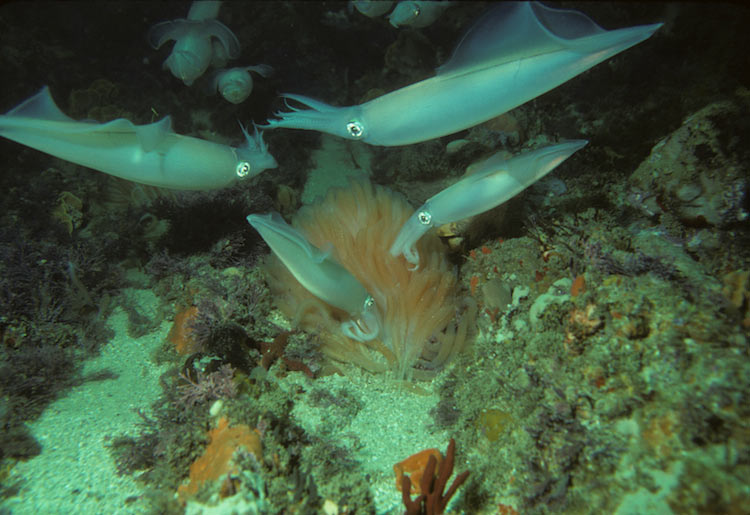This Pheromone Puts Squid in the Mood — To Fight

A newfound chemical drives male squid berserk, and the molecule appears similar to ones seen in humans, scientists now say.
Future research might investigate whether comparable human semen proteins have similar effects, investigators added.
Scientists investigated the longfin squid (Loligo pealeii), which live for nine to 12 months, usually mating and laying eggs in the spring, when the animals migrate from deep offshore waters to shallower waters along the Eastern Seaboard from North Carolina to Maine. Females mate several times with multiple males, who compete fiercely over females.
While in the field, scientists noticed that male squid were visually attracted to the tens of thousands of eggs laid on the seafloor. After just one touch of the eggs with their arms or heads, the researchers found that males immediately and dramatically went from swimming calmly to extreme aggression, including grappling, fin beating and forward lunging.
The culprit appears to be a single protein, a pheromone found on the outside surface of egg capsules. Coming in contact with this molecule will typically cause males to battle with other males, apparently in an attempt to get at females, even when females are not around.
This molecule appears to be the first aggression-triggering pheromone known in any marine animal. Scientists have discovered a number of pheromones that can spark aggression in land-based animals, and this research can similarly help understand critical signals in the oceans.
Aggression between males is widespread in the animal kingdom, where it is linked with acquiring or keeping shelter, food and mates. Aggression is generally thought to be a rather complex process, involving some combination of neural, hormonal, physiological and psychological stimuli.
Sign up for the Live Science daily newsletter now
Get the world’s most fascinating discoveries delivered straight to your inbox.
"Instead, we have an animal that, if it just touches this molecule, bam, the aggression happens instantly," researcher Roger Hanlon, a behavioral ecologist at the Marine Biological Laboratory at Woods Hole in Massachusetts, told LiveScience. "A link between a molecule and a behavior that is that direct is not the commonest thing in science."
Lab experiments showed that whichever male touches the eggs first becomes aggressive faster than ones that reach the eggs later. This head start leads those males to achieve greater dominance.
"Dominant males pair with the females and mate more often, and they gain greater fertilization success, so the extremely competitive aggression has a payoff," Hanlon said.
This pheromone is produced in the female reproductive tract and embedded in the outer surface of eggs. After purifying the pheromone and presenting it to male squid in the lab, Hanlon's team found it sparked the same extreme aggression, even when it was "painted" translucently on a glass vial that contained squid eggs.
"The contact pheromone was incredibly resistant to degradation," said researcher Gregg Nagle at the Medical College of Georgia. "It appears to remain intact for an extended period of time until the eggs are seen and contacted by male squid."
Intriguingly, the pheromone in question belongs to a family of proteins found in humans and other animals, Hanlon said. These "beta-microseminoproteins" are generally found in reproductive glands and are seen at high levels in human and mouse semen.
"The functions of beta-microseminoproteins in vertebrates have not been determined, but our findings in squids may inspire other researchers to consider similar functions in higher vertebrates," Hanlon said.
Much remains uncertain as to what these proteins do in vertebrates, or how their effects work in squid. "It may turn out that they play quite different roles in vertebrates, but at least there's something to go by now," Hanlon said.
The scientists detailed their findings online Feb. 10 in the journal Current Biology.










